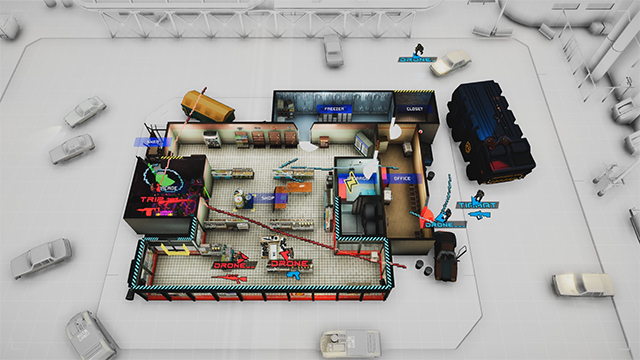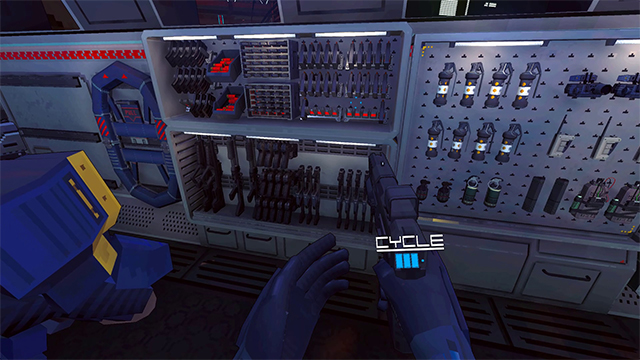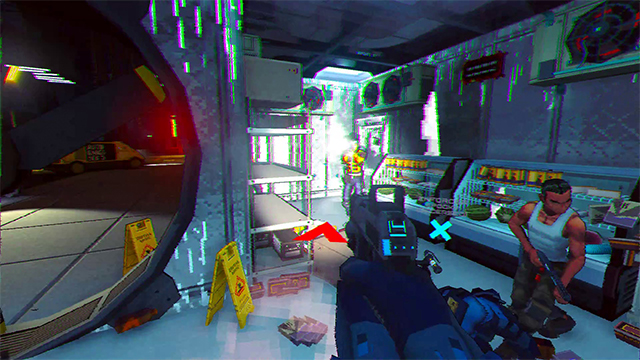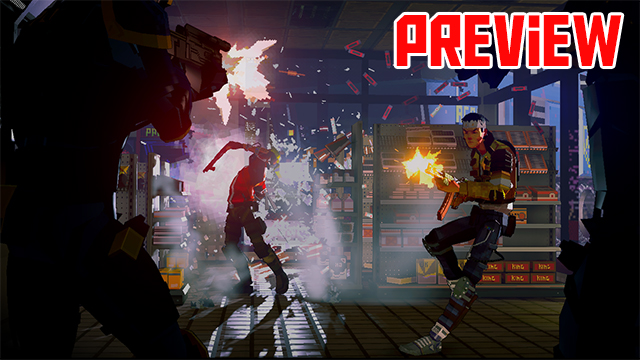Metas carry all competitive games and can turn fun games into cold data, spreadsheets, and numbers. No game is more evocative of this than Pokemon as the coolest creatures can be forsaken for a dorky toaster with hands because of stats. First-person shooters don’t exactly have dorky toasters but they do fall into metas all the same where players can slip into a groove of where to go. Due Process is a competitive PC shooter that’s trying to change that through procedurally generated levels and maps that are easy to literally draw plans on. And it’s a sweeping enough change that just might work.
Due Process still has recognizable roots though. It is set on a map where defenders must defend against the attacking attackers and thankfully has fast, precise first-person shooter controls that keep up with its demanding action. But it splits from there. As was previously mentioned, those maps are procedurally generated, which means you can’t go to the hallway and snipe people like you always do. You have to have a different plan because that hallway probably isn’t going to be there.
Immediately, you’re forced to think on your feet and that was what Vincent Grubbs, lead designer at developer Giant Enemy Crab, described as “learning tactics and not the map.” Many multiplayer games can devolve into patterns at times since you know how to attack certain objectives since you’ve played the map a hundred times. A meta develops as routines are created. That process was something that Grubbs wanted to address right off the bat through procedural generation.
ALSO: How Due Process took inspiration from the Die Hard arcade game
“We determined that the angle we wanted to take to attack this [map meta] problem was procedural generation,” he stated. “We immediately realized that when players haven’t seen a map before, they are forced to figure out how they are going to defend this space and use the resources at their disposal. They’re not only encouraged to talk to each other, they are deeply rewarded by just having a tiny bit of coordination.”
Due Process Preview | The calm before the storm

Procedural maps are something that can truly only be tested after long play sessions and not a 30-minute demo at PAX West. But seeing the developers — people who have played this game for dozens or hundreds of hours — have to explicitly coordinate at every turn using the in-game tools and voice chat gave credence to the idea actually working in the wild.
All of this coordination is facilitated through and encouraged by the game’s real-time map. Players can drag and drop their icon to a place they want to fend or attack and draw lines and circles with the mouse that indicate where they want to go. You don’t have to necessarily say you’re going to run to the doorway on the north entrance; you can just draw a circle there.
Those sloppy, chicken scratch lines and circles appear in the game too, meaning you can literally follow a line to its destination. Literally scribbling a path is easy enough for anyone to follow, even though there unfortunately didn’t appear to be multicolored lines to differentiate between players. The map even updates in real-time, meaning you can see your teammates’ tiny character models scurry about like lab mice in a maze. Although there is no cheese here. Just bullets.
It’s an incredibly clever way to get people to communicate because it takes out a layer of obfuscation and is technically a way to tell your teammates what you’re doing without actually saying it. Apex Legends’ ping system is similar in that it cuts out the boring, top-level parts of teamwork and gets right to it. Grubbs even spoke about how this was one of the first things in the game and how it pointed out that they needed procedurally generated maps before being an essential part of them.
“You put in the map drawing and you have a static map that a level designer made, and immediately after four or five rounds, you see no reason to draw because you know exactly what you are going to execute,” he explained. “The map drawing pushed the necessity of if you’re going to draw a unique plan every time, the map has to be unique every time.”
Due Process Preview | Choices, choices, and more choices

Unique maps and streamlined planning work together in tandem to create a one-of-a-kind experience but the game’s limited armory system ties it all together. Attackers and defenders all have access to their own vaults that store ammo, special items, and guns that the team must make last through the entire phase. This automatically creates tension because you can take a ton of grenades and charges to push for a door, but then you’ll be short for the next round. And you’ll be boned if you all die with that equipment. Survivors keep their equipment for the next round but that obviously doesn’t apply to corpses.
According to Grubbs, procedural generation required flexibility and that flexibility is greater enhanced by a dwindling resource pool. Overly effective strategies would pop up and suck out the tension of planning that every part of the game is trying to encourage. Because why wouldn’t you take all the flashbangs and shotguns if they just reappeared every time? Ammo is limited too and the guns don’t have magic bullets either, meaning that reloading after every few rounds will forfeit the rest of that entire magazine. It puts more pressure on you to think on how you shoot and what ammo you take, which fits what Grubbs and the team is going for.
“We needed a combo having strategic elements that stretch what you want to do based on how much you want to spend to win over three rounds,” said Grubbs. “If we didn’t have limited resources, the procedural generation wouldn’t give us exactly what we wanted. We needed both angles. We wanted you to decide what you’re spending and well as seeing something unique and new so you could figure out how you’re going to spend it.”
Due Process Preview | Competitive shooting… now in color!

But for all of its hardcore aspects, the game’s art style does not scream “hardcore online shooter.” Vibrant pinks and yellow flood the screen in blocky, PS1-style graphics, which is odd for a genre usually suited toward gritty, dark hues that are skewed toward realism. Giant Enemy Crab is not a big studio — around 18 people — so that stylized aesthetic is likely easier than rendering photorealistic models and highly destructible environments.
The late ‘90s, PS1-like visuals look completely unique and give the game an initial differentiation factor that’s instantly striking. And the game’s bright color palette helps reinforce that notion. Although PS1 games didn’t directly inspire Due Process’ style. It was mostly the arcade games of the era.
“If you look at games like Time Crisis or House of the Dead or the Die Hard arcade game, they have advanced graphics for that time because they had fixed perspectives and they knew exactly what they were going to have on the screen,” Grubbs said. “That is the style we wanted: the advanced graphics of the ‘90s. You only really saw those in the arcade machines because the PS1 and N64 couldn’t handle it.”
Modern consoles also won’t be enjoying Due Process anytime soon as the game is still only currently planned for PC since the team doesn’t have the bandwidth to port it. Regardless, it has ideas that work together in unison to create a competitive PC shooter that promises to be different every time you play. People tend to like patterns and Due Process’ mission to get them to actually enjoy planning while in unknown territory might be bold enough to work. Its art style and approach to procedural generation seem to be fitting together quite well at this early stage, meaning this process might be worth doing whenever it does actually come out.







